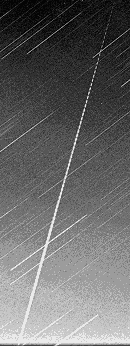DMS-members observing the Geminids 1996
An investigation of the 20 * 36 = 720 negatives show a lot of meteortrails and some of them are really great! We have photographed over 200 meteors of which 140 are multistation; mainly with team Pisces Orientalis at Varsseveld and Jaap van 't Leven in Bosschenhoofd. All images containing meteortrails are transferred to photo-CD. We have made a selection of the finest pictures. They are available right now!
 Left: Geminid of +1 at 04:09:12 in Virgo; Right: Geminid of 0 at 04:03:20 in Virgo |
 Left: Geminid of 0 between 01:16 and 01:34 in Cygnus Right: Geminid of -2 at 01:25:16 in Draco/Hercules |
  Left: Geminid of -4 in Cam/Lyn at 04:48:49 Right: Geminid of -3 in Boo/Ser at 04:35:57 |
  Left: Geminid of -3 in Cvn at 23:54:41; Right: Geminid of -1 in Leo at 00:31:20 |
Our colleagues of team Pisces Orientalis at Varsseveld and Jaap van 't Leven at Bosschenhoofd operated similar photographic equipment thus we hope a considerable number of the photographed meteors will be multistation. This will enable us to compute orbital elements.
Photographic equipment and working method:
Team Delphinus uses 3 camera-array's equiped with Canon T-70 which are controlled
by a fully programmable command back 70.
The low array (9 camera's) is aimed at an elevation of 25 degrees, the middle array
(7 camera's) is aimed at an elevation of 50 degrees and the high array (4 camera's)
at 75 degrees. All camera's are equiped with 1.4/50 mm or 1.8/50 mm objectives which
are stopped down to 2.8 to get sharper images. We use Kodak T-max 400 which is
developed for about 8 minutes in Kodak T-max at 24 degrees centigrade.
The exposuretime ranges from 18 minutes for the low array to 20 minutes for the high
one. Exposures started at 19:30 UT and ended at 06:00 UT.
All camera-array's are equiped with a rotating shutter made up of 4 blades of 30 degrees
each. It's rotational speed is 12.5 rps which yields 50 breaks per second. The shuttermotor
is cristal controlled which makes it possible to calculate orbital elements with higher
accuracy.
Please refer to the photographic section at the DMS-website and IMO-website for further information regarding photographic techniques.